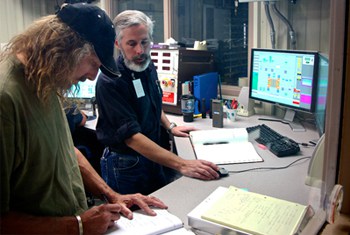
By Tushna Commissariat
Last week saw researchers at the Los Alamos National Laboratory (LANL), US, set a new world record for the strongest magnetic field produced by a “non-destructive” magnet. The scientists achieved a field of 92.5 T (tesla) on 18 August, and then surpassed their own achievement the following day with an impressive 97.4 T field. This meant they beat the previous record that had been held by a team in Germany, who achieved 91.4 T on 22 June 2011.
While the total duration of the pulse was 2.5 seconds, the magnetic field was held to within 1% of the peak field (at both 97.4 T and 92.5 T) for approximately 1 millisecond. The 97.4 T achievement was met with jubilation as four main researchers certified with their signatures the data that would be sent to the Guinness Book of World Records.
This advance improves our ability to create non-destructive magnetic fields – higher-power magnets routinely rip themselves to pieces due to the large forces involved – that serve as tools to study the fundamental characterization of advanced materials such as graphene or high-temperature superconductors. They also confine electrons to nanometre-scale orbits, which reveal the fundamental quantum nature of a material.
LANL spokesperson James Rickman told physicsworld.com that “This is the largest non-destructive magnet ever created on Earth to our knowledge. Destructive magnets routinely generate higher fields for microseconds of duration – many thousands of times shorter. Destructive magnets are reported to have reached 2800 T and require the use of tens of kilos of high explosives.” For perspective, the Earth’s magnetic field is 0.0004 T, while a magnet used to move a large amount of metal (like a car in a junkyard) would be 1 T and a medical MRI scan would have a magnetic field of 3 T.
The researchers generated their field using a combination of two electrical pulsed power systems. A massive 1.4 GW generator is used to power the outer coils of the magnet system and a high performance capacitor bank is used to power the inner sections of the electromagnets. Both power systems are run in a “pulse” mode of operation. The image above shows researchers Yates Coulter (left) and Mike Gordon making their final preparations before successfully achieving the record.
With this achievement, the Pulsed Field Facility at LANL will routinely provide scientists with magnetic pulses of 95 T, attracting scientists from all over the globe for a chance to use this technology. The team are now looking to achieve a 100 T field – something that researchers from around the world, including Germany, China, France and Japan are trying to achieve.



